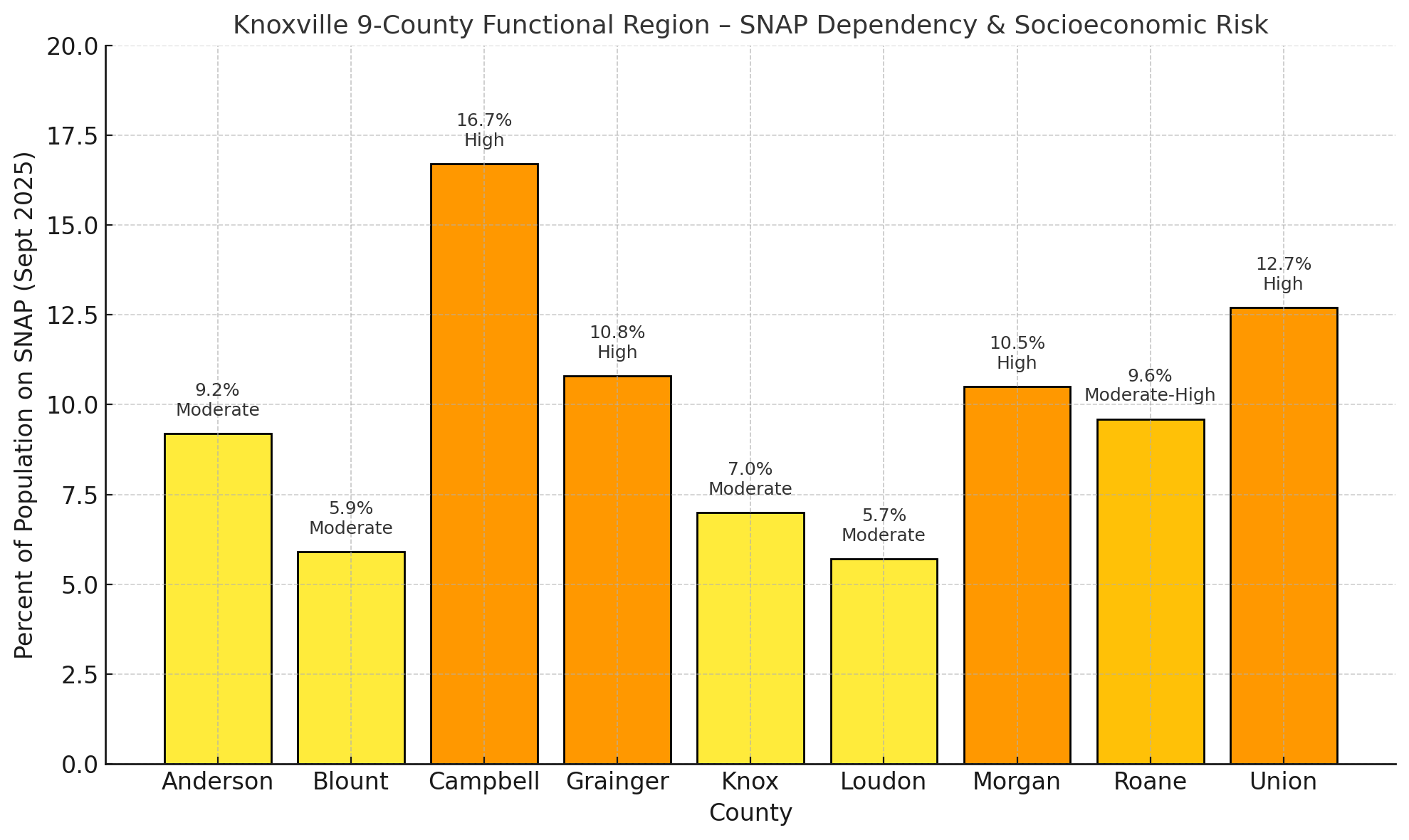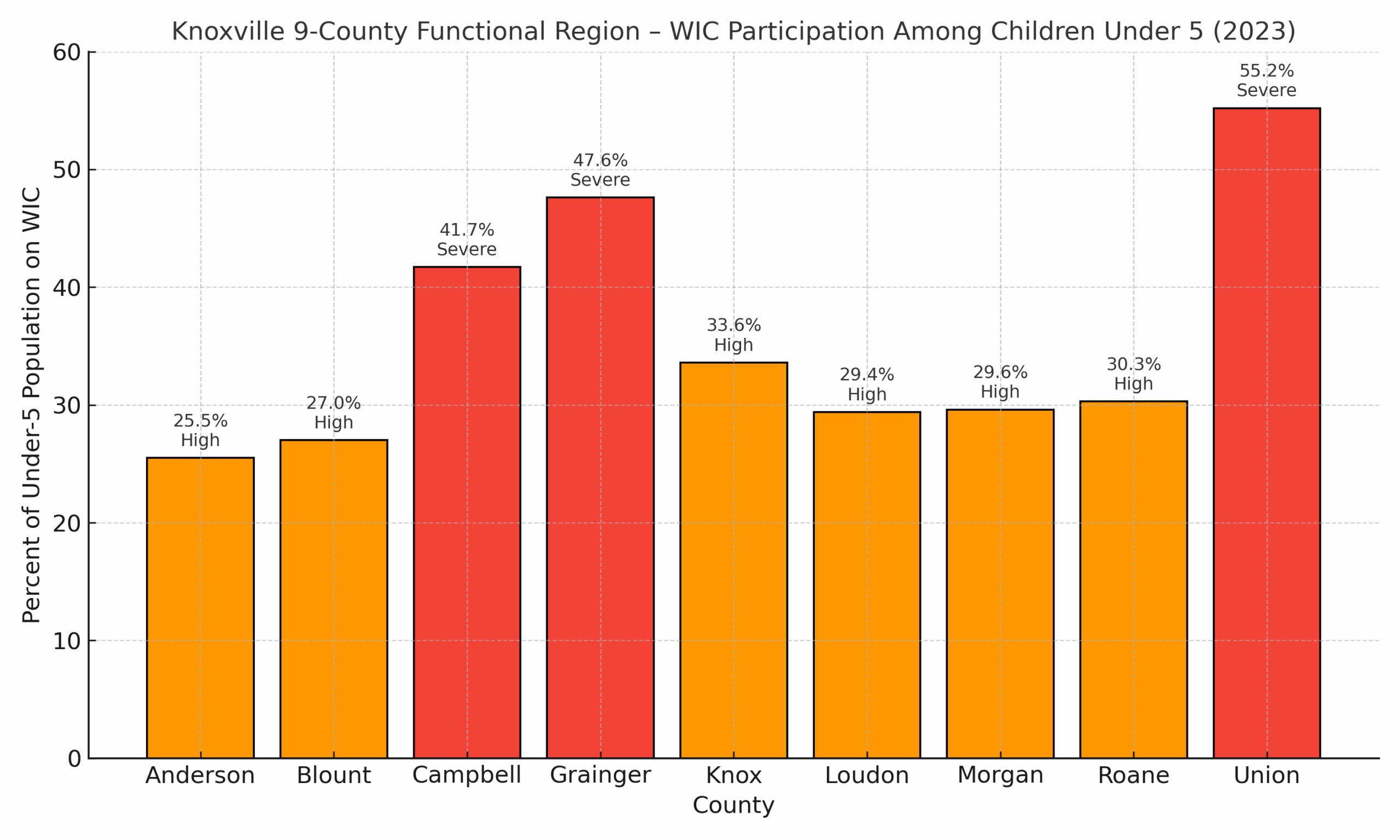Summary
Overall regional vulnerability is Moderate, with High risk concentrated in Campbell, Union, Morgan, and Grainger. Key takeaways are:
- Most likely scenario: temporary hardship and scattered unrest, not sustained violence.
- Highest risk windows: first 7–10 days of missed SNAP disbursement or visible fuel/utility price spikes.
- Most effective mitigation: proactive local coordination, transparent information flow, and calm, visible community presence.
Emergency Management & Support Organization Recommendations
Agencies and organizations should:
- pre‑stage mass‑care resources in high‑risk counties
- coordinate with utility providers on shutoff protections
- expand food‑assistance capacity in Knox County to absorb surge demand if federal benefits lapse.
Mutual Assistance Group & Resident Preparedness Recommendations
Mutual Assistance Groups and residents should:
- maintain situational awareness by collecting information from official/trusted sources
- share eyewitness reports using redundant communication methods
- continue to ensure that appropriate food, supplies, and water are stored/rotated to reduce dependence on the retail supply chain
- avoid accessing grocery stores that serve large SNAP populations during peak times
- check on vulnerable members of their community to determine what resources could be utilized to mitigate impacts
Appendix A: SNAP Risk Definitions
|
SNAP Participation %
|
Risk Level
|
EM Tier Definition
|
|
0–5 %
|
Low
|
Stable socioeconomic base; minimal service-disruption sensitivity.
|
|
5.1–10 %
|
Moderate
|
Noticeable vulnerable-population presence; aid demand spikes if services lapse.
|
|
10.1–20 %
|
High
|
Significant vulnerability; high aid dependence; disruptions produce immediate humanitarian impacts.
|
|
> 20 %
|
Severe
|
Systemic dependency; prolonged disruption yields cascading effects (public safety, health, unrest).
|
Appendix B: SNAP Vulnerability Risk Matrix by County
|
County
|
SNAP % of Population
|
Assigned Risk Level
|
Rationale / EM Notes
|
|
Anderson
|
9.2 %
|
🟡 Moderate
|
Aging industrial economy; Oak Ridge corridor moderate dependency; manageable but rising if benefits lapse.
|
|
Blount
|
5.9 %
|
🟡 Moderate (Low edge)
|
Growing suburban economy; pockets of need in Maryville/Alcoa; strong NGO presence lowers systemic risk.
|
|
Campbell
|
16.7 %
|
🟠 High
|
Chronic rural poverty; limited food access; small-town retail base; high aid-demand sensitivity.
|
|
Grainger
|
10.8 %
|
🟠 High
|
Rural, limited transportation and grocery options; hardship likely within 7–10 days of SNAP lapse.
|
|
Knox
|
7.0 %
|
🟡 Moderate
|
Urban core absorbs most recipients; strong infrastructure but high absolute numbers → heavy pantry load.
|
|
Loudon
|
5.7 %
|
🟡 Moderate (Low edge)
|
Growing commuter county; moderate dependency, good access to urban resources.
|
|
Morgan
|
10.5 %
|
🟠 High
|
Appalachian rural mix; limited services; high heating/energy burdens.
|
|
Roane
|
9.6 %
|
🟡 Moderate–High
|
Mixed rural/industrial; older housing stock; increased energy burden during cold months.
|
|
Union
|
12.7 %
|
🟠 High
|
Small population but high dependency; few retail/aid nodes; transport isolation increases risk.
|
Appendix C: WIC Vulnerability Risk Matrix by County
|
County
|
Infants & Children on WIC (2023)
|
% of Under-5 Population
|
Risk Tier
|
|
Anderson
|
1,056
|
25.5 %
|
High
|
|
Blount
|
1,827
|
27.0 %
|
High
|
|
Campbell
|
903
|
41.7 %
|
Severe
|
|
Grainger
|
573
|
47.6 %
|
Severe
|
|
Knox
|
8,953
|
33.6 %
|
High
|
|
Loudon
|
786
|
29.4 %
|
High
|
|
Morgan
|
290
|
29.6 %
|
High
|
|
Roane
|
745
|
30.3 %
|
High
|
|
Union
|
597
|
55.2 %
|
Severe
|
References and Data Sources
Primary Data Sources
Tennessee Department of Human Services (TDHS) – SNAP Program
Tennessee SNAP Statistical Reports (September 2025). County-level participation data: individuals, households, and monthly issuance for Anderson, Blount, Knox, Loudon, and Union Counties.
https://www.tn.gov/humanservices → Public Reports → Family Assistance → SNAP Statistical Information.
→ Public Reports → Family Assistance → SNAP Statistical Information.
U.S. Census Bureau – Vintage 2024 Population Estimates
County-level population estimates used to calculate SNAP participation percentages.
https://www.census.gov/data/tables/time-series/demo/popest/2020s-counties-total.html
Tennessee Housing Development Agency (THDA) – LIHEAP
Program overview, partner-agency directory, and benefit range ($174–$750).
https://thda.org/help-for-homeowners/low-income-home-energy-assistance-program-liheap
U.S. Department of Health and Human Services (HHS) / Administration for Children & Families (ACF)
• LIHEAP Performance Management System – State Profile: Tennessee FY 2024–2025
https://liheappm.acf.gov
• Low-Income Household Water Assistance Program (LIHWAP) – FY 2022 Tennessee Profile; confirms March 2024 program sunset.
https://acf.gov/ocs/programs/lihwap
Tennessee Emergency Management Agency (TEMA) Region 2 / ReadyTN
Regional coordination framework and public guidance on preparedness under funding interruption.
https://www.tn.gov/tema
Tennessee WIC Participation by County (KIDS COUNT / Annie E. Casey Foundation)
Statistics on children, youth and families in Tennessee from the Annie E. Casey Foundation and the Tennessee Commission on Children and Youth. Latest dataset is from 2023.
https://datacenter.aecf.org/data/tables/2999-infants-and-children-receiving-benefits-from-women-infant-and-children-wic-program#detailed/2/any/false/2545,1095,2048,574,1729,37,871,870,573,869/any/13222,10115
“Head Start programs begin to close as funding ends during …” — by CBS News
Reporting about the operational risk of over 140 Head Start programs losing funding if the shutdown persists.
https://www.cbsnews.com/news/head-start-closures-government-shutdown/
“Head Start education program in jaws of US government shutdown” — by Reuters
Reporting about 65,000 children in 41 states face interruption of Head Start services as grants expire.
https://www.reuters.com/legal/government/us-government-shutdown-threatens-shutter-head-start-child-programs-2025-10-30/
Knoxville VOAD Partner Agencies
Local energy- and utility-assistance providers: Knoxville–Knox County CAC, ETHRA, BCCAA, and MECAA.
• CAC – https://www.knoxcac.org
• ETHRA – https://www.ethra.org
• MECAA – https://www.mecaa.net
Secondary / Supporting Sources
OMB Bulletin 23-01 – Defines official Knoxville MSA counties (Anderson, Blount, Knox, Loudon, Union).
East Tennessee Development District (ETDD) Regional Plans (2024) – Defines 9-county functional region.
Second Harvest Food Bank of East Tennessee – 2025 press statements on projected food-pantry demand.
Local Media Reporting
-
Knox News Sentinel – “SNAP, energy-aid delays affect East Tennessee families,” Oct 2025.
-
WBIR / WVLT – “LIHEAP applications delayed statewide amid shutdown,” Oct 2025.
-
Oak Ridger / Daily Times (Maryville) – coverage of “No Kings 2” demonstrations.
Analytical / Derived Data
SNAP
All quantitative estimates generated for SNAP were completed by using the following formula:
SNAP Rate% = (SNAP Individuals divided by County Population) X 100
Risk-Rating Categories
Risk-rating categories were adapted from FEMA/NIMS Community Lifelines vulnerability tiers:
Head Start
- Tennessee Headcount: Per HHS/Headstart.gov there are approximately 16,700 children (Head Start + Early Head Start) funded.
-
Knoxville–Knox County Head Start: 510 Head Start + 184 Early Head Start = 694 children served, ~120 staff — per 2024–25 annual report.
-
Typical staff-to-child ratio: 1:10 to 1:15 depending on age and classroom size. Younger children have higher staff ratios.
-
Regional share: The nine-county Knoxville functional region (Anderson, Blount, Campbell, Grainger, Knox, Loudon, Morgan, Roane, Union) represents roughly 10–15 percent of Tennessee’s population and Head Start footprint.



0 Comments